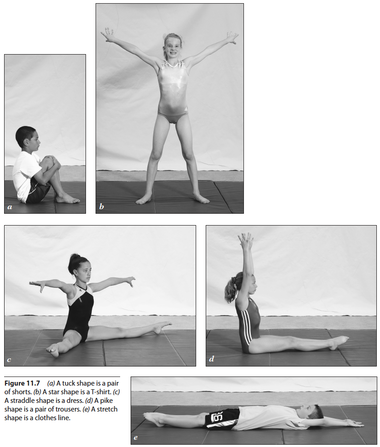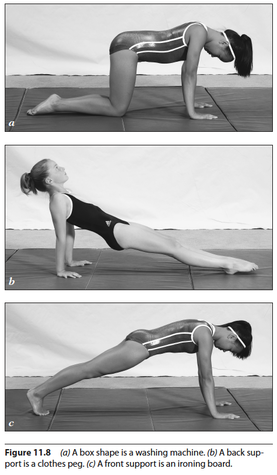Fun game adds variation to the warm-up
This is an excerpt from Complete Guide to Primary Gymnastics by Lindsay Broomfield.
This is a fun game to introduce to young children to add variation to the warm-up. It can be used as a pulse raiser at the beginning of the lesson. Washing clothes is a concept most young children are familiar with.
Learning Intention
Introduce pupils to postural shapes.
Learning Outcome
Demonstrate the box, front support and back support shapes.
Pre-Game Activity
The pre-game activity is identifying the shapes and interpreting their meaning within the rules of the game. Pupils must be familiar with the basic gymnastics shapes, gymnastics postural shapes and concepts relating to washing clothes.
Following are the associated basic gymnastics shapes:
- Tuck shape is a pair of shorts (see figure 11.7a).
- Star shape is a T-shirt (see figure 11.7b).
- Straddle shape is a dress (see figure 11.7c).
- Pike shape is a pair of trousers (see figure 11.7d).
- Stretch shape is a clothes line (see figure 11.7e).

Following are the associated gymnastics postural shapes:
- Box shape is a washing machine (see figure 11.8a).
- Back support is a clothes peg (see figure 11.8b).
- Front support is an ironing board (see figure 11.8c).

Scheme of Work
In the Pictorial Resources folder, refer to the Washing the Clothes files in the Themed Games folder. Washing the Clothes is featured in unit 6 (Basic Shapes, Additional Rolling Techniques and Climbing) on the DVD.
How to Play
1. Ensure that pupils are familiar with the chosen articles of clothing and other items associated with the process of washing clothes.
2. Ensure that pupils are familiar with the basic and postural shapes associated with the named articles of clothing and washing items.
3. Ask pupils to move carefully and quietly around the hall, ensuring that they can see and hear you at all times. They should enact a story that follows a similar narrative: “The children have been outside playing in the mud and are very dirty. Their clothes need to be collected for the washing machine (box). First of all, gather the shorts (tuck shape). Continue walking and collect the dresses (straddle shape). Continue walking and find all the trousers (pike shape). Finally, put the T-shirts (star shape) in the washing basket. Place the clothes in the washing machine (box); after washing them, carry them out to the washing line (stretch shape). Hang the clothes on the line with the clothes pegs (back support). After the clothes blow in the breeze, it is time to collect the clothes. Carry the clothes inside and place them on the ironing board (front support) to be ironed.”
Game Variations and Extensions
You can extend the game with the following variations:
- Include some play activities that can be used as actions in a pulse raiser to start the game.
- Sports: football (kicking a ball), tennis (hitting a ball with a racquet), netball (running and throwing and catching a ball), swimming (doing the best stroke or front crawl), climbing (pretending to climb upwards), skiing (slaloming).
- Gardening: digging the soil, chopping wood, mowing the grass, sweeping up leaves, carrying heavy sacks of leaves or grass.
- Pupils could give themselves a scrub and a wash: Start at the top of the body (the face) and finish at the bottom of the body (the feet).
- The washing machine could go through a wash cycle involving some cyclic actions. For example, simulate washing actions or simulate spinning actions.
- The ironing of the clothes could be extended to encourage further development of core stability.
- Ask a pupil to tell a story for others to enact the actions that would link as a cross-curricular activity with literacy.
Teaching Points
Share the following teaching points with your pupils:
- When moving to collect the washing, remember to walk in and out of the spaces.
- On stop and in a shape, make sure you are in a space.
- On stop and in a shape, are you still? Don't fidget.
- Think about your shape:
- Are you long and narrow for your stretch?
- Are you small and compact for your tuck?
- Are you flat and wide for your star?
- Sit up straight with straight legs and pointed toes for your straddle.
- Sit up straight with straight legs for your pike.
- Make a square box shape for your box.
- Be strong in your middle for your front support.
- Push your tummy upwards for your back support.
- In your shape, point your toes.
SHOP

Get the latest insights with regular newsletters, plus periodic product information and special insider offers.
JOIN NOW


